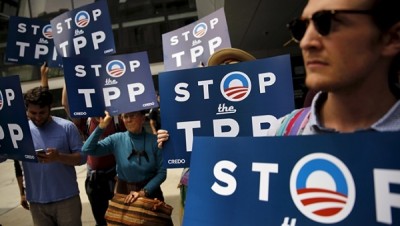Countries Sign The TPP… Whatever Happened To The ‘Debate’ We Were Promised Before Signing?
from the now-the-ratification-fight dept

About an hour ago, representatives from 12 different nations officially signed the Trans Pacific Partnership (TTP) agreement in Auckland, New Zealand. The date, February 4th (New Zealand time) is noteworthy, because it’s 90 days after the official text was released. There was a 90 day clock that was required between releasing the text and before the US could actually sign onto the agreement. The stated purpose of this 90 day clock was in order to allow “debate” about the agreement. Remember, the entire agreement was negotiated in secret, with US officials treating the text of the document as if it were a national security secret (unless you were an industry lobbyist, of course). So as a nod to pretend “transparency” there was a promise that nothing would be signed for 90 days after the text was actually released.
So… uh… what happened to that “debate”? It didn’t happen at all. The TPP was barely mentioned at all by the administration in the last 90 days. Even during the State of the Union, Obama breezed past the TPP with a quick comment, even though it’s supposedly a defining part of his “legacy.” But there’s been no debate. Because there was never any intent for an actual debate. The 90 day clock was just something that was put into the process so that the USTR and the White House could pretendthat there was more “transparency” and that they wouldn’t sign the agreement until after it had been looked at and understood by the public.
Of course, the signing is a totally meaningless bit of theater. The real fight is over ratification. The various countries need to ratify the TPP for the agreement to go into effect. Technically, the TPP will enter into force 60 days after all signers ratify it… or, if that doesn’t happen, within two years if at least six of the 12 participant countries ratify it and those six countries account for 85% of the combined gross domestic product of the 12 countries. Got that? In short, this means that if the US doesn’t ratify it, the TPP is effectively dead. The US needs a majority of both houses of Congress to approve it, similar to a typical bill. And that’s no sure thing right now. Unfortunately, that’s mainly because a group of our elected officials are upset that the TPP doesn’t go far enough in helping big businesses block competition, but it’s still worth following.
Inevitably, there will be some debate during the ratification process, though there are enough rumors suggesting that no one really wants to do it until after the Presidential election, because people running for President don’t want to reveal that they’re happy to sell out the public’s interest to support a legacy business lobbyist agenda. But, even that debate will likely be fairly limited and almost certainly will avoid the real issues, and real problems, with the TPP.
Either way, today’s symbolic signing should really be an exclamation point on the near total lack of transparency and debate in this process. The 90 day window was a perfect opportunity to have an actual discussion about what’s in the TPP and why there are problems with it, but the administration showed absolutely no interest in doing so. And why should it? It already got the deal it wanted behind closed doors. But, at least it can pretend it used these 90 days to be “transparent.”

